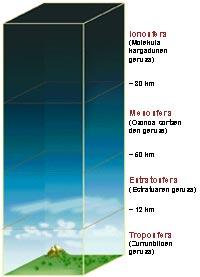The air weighs!
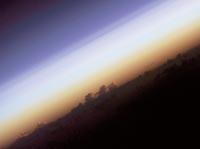
Those who devote themselves to the pedagogy of science often say that people on the street do not understand what the atmosphere is like. Some accepted ideas are not correct. On the one hand, that the air has no weight, it is very widespread. On the other hand, there is no gravity outside the atmosphere, which can be seen in the images of astronauts.
But it is not true. The air has weight. And gravity does not end with the atmosphere. In fact, these two things go together, because the air is stored in the 'bottom' of the zone of gravity, next to the earth's surface, by its weight. To this air of weight we call atmosphere and it affects us a lot. Perhaps we have become accustomed, but we can detect and measure that influence.
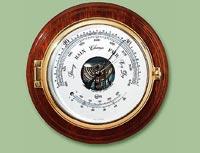
For example, atmospheric pressure. The atmosphere exerts an approximate pressure of one kilo of weight per square centimeter. In latitudes of temperate populations, the average value is usually 1,033.6 grams of pressure. When you open your hand, you put in contact with the atmosphere an area of over one hundred square centimeters. Imagine that with this hand you hold the pressure of more than one hundred kilos.
But be careful, it is not weight but pressure. We live immersed in a gas in which the molecules of that surrounding gas constantly collide against us, like the water molecules against the body of fish. That is the pressure, the shocks of the molecules.
Higher number of collisions, higher pressure. And, of course, the number of collisions depends on the number of molecules; the more molecules there are, the more shocks occur. Therefore, to know if there are many or few gases in a given volume, the concentration of gas is not indicated, but the pressure of the gas. In the case of the atmosphere the same occurs; a high atmospheric pressure means that there are many air molecules, but not above, but by the environment.
Therefore, the body supports this pressure in every way. Taking into account the surface of the body, a kilo of pressure per square centimeter is much for the human being. Or it should be. How does that pressure not fully crush the human body? How does it not? Because the body also exerts pressure from the inside out. It balances the pressure since the body is a structure full of water that also exerts pressure. They are the bodies of all the living. They generate the same pressure they endure in the opposite direction. Precisely for this reason, an astronaut who goes out into space must artificially produce the influence of the atmosphere, not only to be able to breathe, but because it must somehow compensate for the pressure exerted by the body. In the terrestrial surface it is the atmospheric gas that carries out this work.
However, atmospheric pressure is not the same at all heights, the higher the height, the lower the pressure. In short, this means that as we ascend the surface there are fewer gases. It is worth making a trip up to see how the gas is distributed.
Piled at the bottom

It can be said that most of the air is in the lower part; 80% of the atmospheric mass is in the lower ten kilometers. Very close to the sea level. Somehow, the air is accumulated on the earth's surface. The mountaineers know it perfectly; at three thousand meters, for example, the atmosphere is very light, there are only three quarters of the pressure at sea level. This is seen in air density, a liter of air in the sea weighs 1,226 grams and three thousand meters, an average of 0,910 grams. At ten thousand meters, that is, at the height of commercial planes, the liter of air weighs only 0.413 grams. In his air there is much less gas, much less matter. It seems that a plane cannot fly up, because that gas has to endure to fly.
On the other hand, it is known that in this ascension the temperature also changes. Normally, when climbing about 180 meters, the temperature drops one degree, due to the heat exchange with the Earth. The Earth heats up the lower part of the atmosphere. Therefore the temperature drops as it increases. But this does not happen in the whole atmosphere. From a limit, the temperature of the atmosphere does not diminish any more, it is about 50 degrees below zero.

The part of the atmosphere to that limit is called troposphere and the border itself is called tropopause. They are very appropriate names, since the prefix 'tropo' means change. The area is very variable, the air moves a lot in all directions, it heats up and cools, producing many trailers. The balance is never reached, where all meteorological phenomena occur.
But in the tropopause the situation changes radically. The action of the earth's crust is very weak, since on the one hand it is very far and on the other, the air is very light. There are few molecules, so the pressure is low. And the heat exchange occurs through intermolecular shocks. Since there are fewer air molecules in the tropopause than on the terrestrial surface, the heat transmission is slower.
Another sky

The tropopause is 10 kilometers high, but not always or everywhere. It is lower at the poles and higher at the equator. In winter low and rises in summer. In short, when the temperature rises, also the tropopause. In fact, some scientists believe that the global warming of the planet has caused hundreds of meters of climbing to the tropopause, but there are few data and many doubts.
However, in the tropopause the situation changes a lot. The air also moves upwards, breathes fast air, but not upwards or downwards, but horizontally. Strata. It is no wonder that scientists have given this part the name of the stratosphere.
The truth is that there is a reason for it to be so. The temperature of the air increases in the stratosfer as increased. Therefore, the hot air accumulates in the upper part and the cold in the lower part, that is, the lighter air is located in the upper part and the heavier in the lower part, and no upward or descending air currents are generated by density. The opposite of what happens in the troposphere.


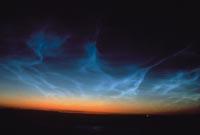
From the point of view of the currents, this situation is perfect for flying. On commercial flights, the planes go up to the stratosphere because it is an area without turbulence.
And from other points of view, the stratosphere is very special. For example, from the point of view of chemical composition. The composition of the stratosphere is very similar to that of the troposphere. However, the exchange of matter between the two layers is very slow, since in the stratosphere the gas hardly flows up or down. It is true that in the eruptions of some volcanoes the gases arrive there, but do not alter much their composition.
There are two significant differences between troposphere and stratosphere gases. The first lack of water. Water does not reach the stratosphere, it condenses and falls to Earth. There is a little, but what has been created there. And that little water needs a very low temperature to create clouds. Consequently, in the stratosphere, there are few clouds forming on the poles.
The second difference is the presence of the most famous molecule in the stratosphere: ozone. Who has never heard of the ozone layer in the stratosphere? Solar radiation is generated from oxygen and is trapped in the layers of air currents. It has no leaks while it is not associated with contaminants. Less bad, this ozone absorbs ultraviolet rays.
Most of the ozone is found in the stratosphere, but it is also detected from there. The truth is that at the upper limit of the stratosphere, in the stratosphere, there is not much gas; there are very few molecules, very low pressure. It is located about 50 kilometers from the land surface.
And beyond, in the mesosphere, much less. However, their behavior is important. As they are very few, very few impacts occur between them. This means that the heat transmission is very slow.
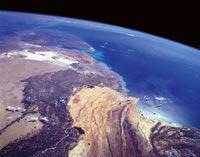
It is believed that this has to do with the change of temperature. As this layer is ascended, the temperature decreases, contrary to what happens in the stratosphere. It also reaches 100 degrees below zero. And in these conditions the clouds are condensed. There are clouds in the mesosphere! They are called cloud nocuas. They can sometimes be seen in the dark. But scientists know little about these clouds.
In any case, there is not much matter above. And, therefore, the mesosphere is not protected from the influence of space. Ultraviolet rays are easily ionizable by these few molecules, and there are many other processes, among which is the large amount of stratospheric ozone.
In short, the influence of space on the mesosphere is greater than that of the Earth. But the mesosphere is the first one that welcomes the spacecraft that return to Earth. Perhaps not from the point of view of the molecules that provoke friction, but because the wind and the turbulent begin to be noticed there. There is very little matter, but the ship detects those kilometers of flight.
For the space
The atmosphere does not end there. However, beyond there is hardly anything. Only a few ionized molecules remain. But they have consequences. On the one hand, they reflect many radio waves. The waves come from the terrestrial surface and reflect the terrestrial surface. That is why we can listen to a radio program broadcast in Araba in Euskal Herria. This effect is, moreover, stronger during the nights, when solar radiation has disappeared.
On the other hand, it is said that in this layer the temperature increases again with height. However, in these conditions the concept of temperature changes a lot. The molecule is insufficient to talk about the actual temperature. It is difficult to measure because for it they would have to transmit heat their molecules. But there are hardly any molecules.
However, it has been considered as a high temperature layer, which has been called termosfera. However, because there are ionized molecules, the name of ionosphere is also used to speak of the upper part of the atmosphere.
The last molecules of the atmosphere are located 600 kilometers or farther from the terrestrial surface. But they are so scarce to say what the limit is almost impossible. There is hardly anything. Finish the gas over you. We are in space. In the black space.
Clouds, the visible atmosphere
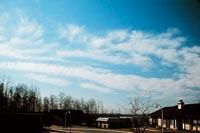
The air is not seen. When the water vapor of the air is condensed, the clouds are seen. They acquire gaseous appearance but are not of gas. They are liquid, small drops of water and, if the temperature at the time of condensation is very low, small crystals of ice. Therefore, they are solid or liquid. And that is what they perceive, among other things, who fly in ultra-fast planes. Entering a cloud is like crashing into thousands of particles.
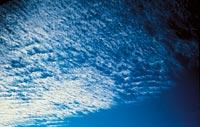
There are many types of clouds, but all are generated by cooling of the air water vapor. The steam is condensed and the drop becomes liquid and, at very low temperature, in a tiny glass of ice. And, although condensed, the drops do not fall to the ground, since they are dragged by small currents of air.
And everything is related. These air currents also influence the formation of clouds. The clouds that form in slow winds are organized in layers, while those produced in strong winds develop upwards.
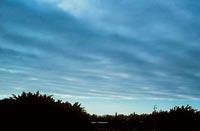
But experts not only classify clouds according to their structure. They consider important the height to which the cloud appears. More than five thousand meters are dominated by cirros. As the temperature at that height is very low, the ice crystals form the cirrus. Strong winds lengthen, but may have other shapes. Those who form a thin layer that totally covers the sky are called circaras, while those who have long pieces of cotton are called circaras.

Slightly below, at two thousand meters of height, the clouds that are generated have mainly liquid water. They are called altostrata and altocumulus, of small and great thickness respectively. In the lower clouds the strata predominate. The typical rainy clouds are nimboestrated, and although the sky is totally covered by the stratomulus that leaves no rain. Sometimes these low clouds extend in the form of fog and their structure is difficult to detect, and are formed by strata.

Some clouds create increasing water vapours. It can be because the air heated by the terrestrial surface cools when climbing. Or because a mountain range makes the air rise. Or where the hot air meets the cold air, in a front, because the hot air rises and eventually cools down. The clouds generated in these modes are of vertical development, clusters. Some give giant mountains, giant mountains shaped like mushrooms. These clusters are called cumulonimbos.



